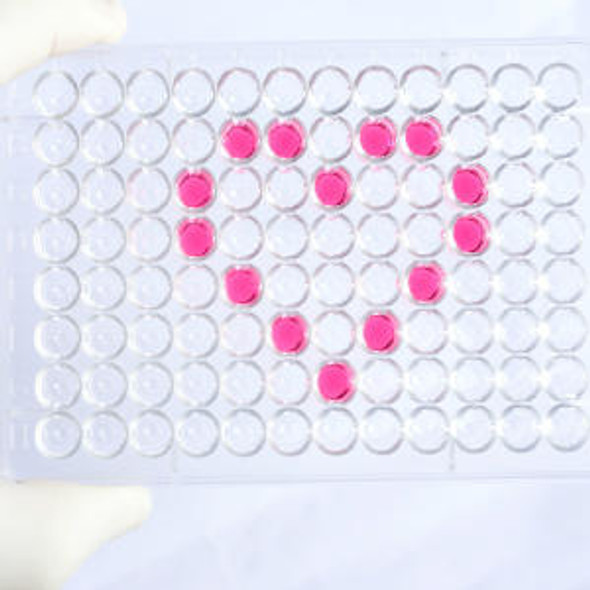Signal Transduction Antibodies 1
Anti-P2RX7 Antibody (CAB10511)
- SKU:
- CAB10511
- Product Type:
- Antibody
- Reactivity:
- Human
- Reactivity:
- Mouse
- Reactivity:
- Rat
- Host Species:
- Rabbit
- Isotype:
- IgG
- Antibody Type:
- Polyclonal Antibody
- Research Area:
- Signal Transduction
Description
| Antibody Name: | Anti-P2RX7 Antibody |
| Antibody SKU: | CAB10511 |
| Antibody Size: | 20uL, 50uL, 100uL |
| Application: | WB IHC |
| Reactivity: | Human, Mouse, Rat |
| Host Species: | Rabbit |
| Immunogen: | Recombinant fusion protein containing a sequence corresponding to amino acids 47-334 of human P2RX7 (NP_002553.3). |
| Application: | WB IHC |
| Recommended Dilution: | WB 1:1000 - 1:2000 IHC 1:50 - 1:200 |
| Reactivity: | Human, Mouse, Rat |
| Positive Samples: | A375, HT-29, U-251MG, LO2, Mouse heart, Rat liver |
| Immunogen: | Recombinant fusion protein containing a sequence corresponding to amino acids 47-334 of human P2RX7 (NP_002553.3). |
| Purification Method: | Affinity purification |
| Storage Buffer: | Store at -20'C. Avoid freeze / thaw cycles. Buffer: PBS with 0.02% sodium azide, 50% glycerol, pH7.3. |
| Isotype: | IgG |
| Sequence: | SDKL YQRK EPVI SSVH TKVK GIAE VKEE IVEN GVKK LVHS VFDT ADYT FPLQ GNSF FVMT NFLK TEGQ EQRL CPEY PTRR TLCS SDRG CKKG WMDP QSKG IQTG RCVV YEGN QKTC EVSA WCPI EAVE EAPR PALL NSAE NFTV LIKN NIDF PGHN YTTR NILP GLNI TCTF HKTQ NPQC PIFR LGDI FRET GDNF SDVA IQGG IMGI EIYW DCNL DRWF HHCR PKYS FRRL DDKT TNVS LYPG YNFR YAKY YKEN NVEK RTLI KVFG IRFD ILVF GTGG KFDI IQLV |
| Gene ID: | 5027 |
| Uniprot: | Q99572 |
| Cellular Location: | Cell membrane, Multi-pass membrane protein |
| Calculated MW: | 14kDa/31kDa/35kDa/41kDa/49kDa/58kDa/68kDa |
| Observed MW: | 65kDa |
| Synonyms: | P2RX7, P2X7 |
| Background: | The product of this gene belongs to the family of purinoceptors for ATP. This receptor functions as a ligand-gated ion channel and is responsible for ATP-dependent lysis of macrophages through the formation of membrane pores permeable to large molecules. Activation of this nuclear receptor by ATP in the cytoplasm may be a mechanism by which cellular activity can be coupled to changes in gene expression. Multiple alternatively spliced variants have been identified, most of which fit nonsense-mediated decay (NMD) criteria. |
| UniProt Protein Function: | P2X7: a receptor for ATP that acts as a ligand-gated ion channel. Responsible for ATP-dependent lysis by macrophages through the formation of membrane pores permeable to large molecules. Activation of this nuclear receptor by ATP in the cytoplasm may be a mechanism by which cellular activity can be coupled to changes in gene expression. Alternatively spliced variants encoding different isoforms have been identified. Could function in both fast synaptic transmission and the ATP-mediated lysis of antigen-presenting cells. Phosphorylation results in its inactivation. |
| UniProt Protein Details: | Protein type:Channel, ligand-gated; Membrane protein, integral; Membrane protein, multi-pass; Receptor, misc. Chromosomal Location of Human Ortholog: 12q24.31 Cellular Component: cytoplasm; integral to nuclear inner membrane; integral to plasma membrane; membrane; plasma membrane Molecular Function:ATP binding; ATP-gated cation channel activity; lipopolysaccharide binding; protein binding; purinergic nucleotide receptor activity; receptor binding Biological Process: bleb formation; blood coagulation; cell surface receptor linked signal transduction; membrane depolarization; negative regulation of bone resorption; negative regulation of cell volume; negative regulation of MAPKKK cascade; phospholipid scrambling; pore complex biogenesis; positive regulation of bone mineralization; positive regulation of cytolysis; positive regulation of cytoskeleton organization and biogenesis; positive regulation of glycolysis; positive regulation of interleukin-1 beta secretion; regulation of sodium ion transport; response to ATP; sensory perception of pain Disease: Leukemia, Chronic Lymphocytic |
| NCBI Summary: | The product of this gene belongs to the family of purinoceptors for ATP. This receptor functions as a ligand-gated ion channel and is responsible for ATP-dependent lysis of macrophages through the formation of membrane pores permeable to large molecules. Activation of this nuclear receptor by ATP in the cytoplasm may be a mechanism by which cellular activity can be coupled to changes in gene expression. Multiple alternatively spliced variants have been identified, most of which fit nonsense-mediated decay (NMD) criteria. [provided by RefSeq, Jul 2010] |
| UniProt Code: | Q99572 |
| NCBI GenInfo Identifier: | 395398617 |
| NCBI Gene ID: | 5027 |
| NCBI Accession: | Q99572.4 |
| UniProt Secondary Accession: | Q99572,O14991, Q4VKH8, Q4VKH9, Q4VKI0, Q4VKI1, Q4VKI2 A8K2Z0, E7EMK6, F5H6P2, F5H7E8, F8W951, |
| UniProt Related Accession: | Q99572 |
| Molecular Weight: | 69kDa |
| NCBI Full Name: | P2X purinoceptor 7 |
| NCBI Synonym Full Names: | purinergic receptor P2X 7 |
| NCBI Official Symbol: | P2RX7 |
| NCBI Official Synonym Symbols: | P2X7 |
| NCBI Protein Information: | P2X purinoceptor 7 |
| UniProt Protein Name: | P2X purinoceptor 7 |
| UniProt Synonym Protein Names: | ATP receptor; P2Z receptor; Purinergic receptor |
| Protein Family: | P2X purinoceptor |
| UniProt Gene Name: | P2RX7 |








